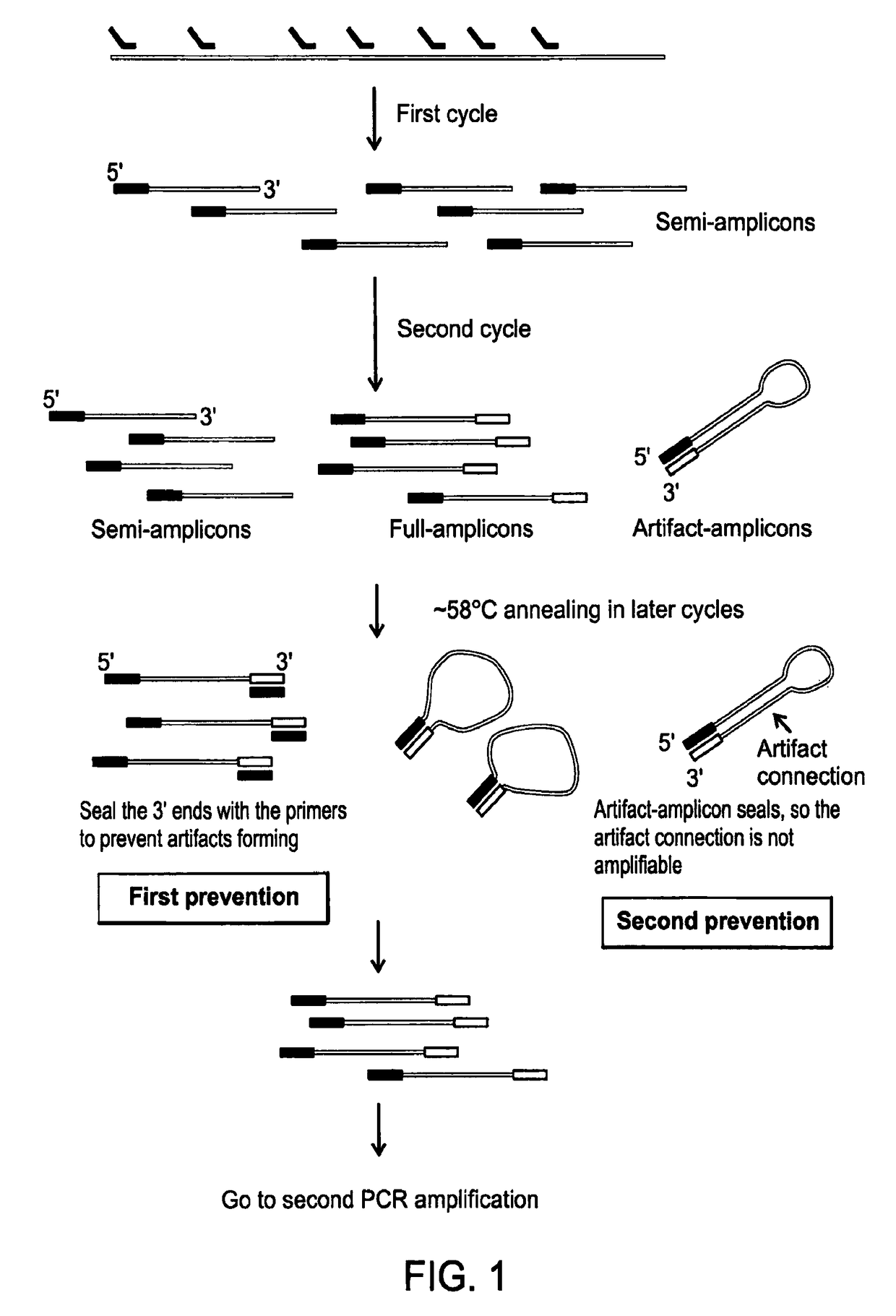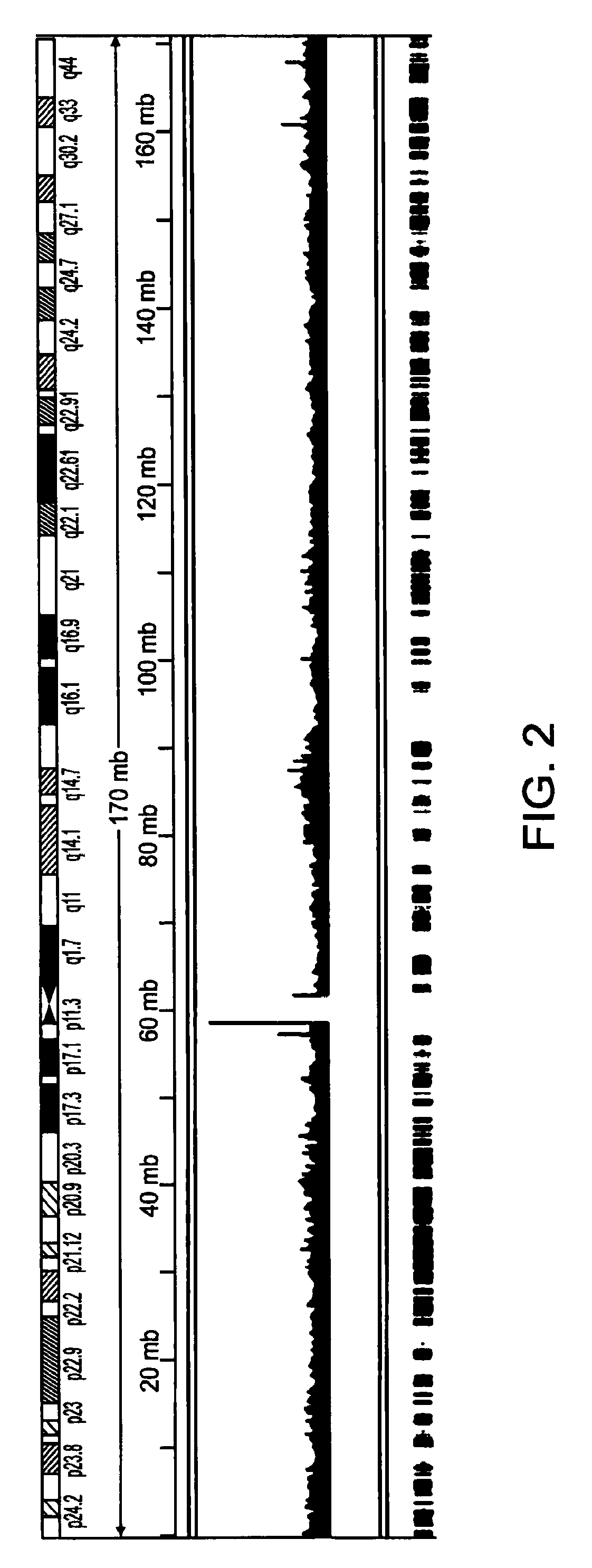Methods of amplifying whole genome of a single cell
a single cell, whole genome technology, applied in the direction of dna preparation, biochemistry apparatus and processes, fertilization, etc., can solve the problems of inability to amplify the genome in its entirety, short amplification products, and common formation of primer dimers
- Summary
- Abstract
- Description
- Claims
- Application Information
AI Technical Summary
Benefits of technology
Problems solved by technology
Method used
Image
Examples
example i
Single Cell DNA Amplification
Cell Selection by Laser Dissection Microscopy
[0108]A cell is selected, cut from a culture dish, and dispensed in a tube using a laser dissection microscope (LMD-6500, Leica) as follows. The cells are plated onto a membrane-coated culture dish and observed using bright field microscopy with a 10× objective (Leica). A UV laser is then used to cut the membrane around an individually selected cell such that it falls into the cap of a PCR tube. The tube is briefly centrifuged to bring the cell down to the bottom of the tube. 5 μl lysis buffer (30 mM Tris-Cl PH 7.8, 2 mM EDTA, 20 mM KCl, 0.2% Triton X-100, 12.5 μg / ml Qiagen Protease) is added to the side of the PCR tube and span down. The captured cell is then thermally lysed using the using following temperature schedule on PCR machine: 50° C. 3 hours, 75° C. 20 minutes, 80° C. 5 minutes.
Linear Pre-Amplification
[0109]In the linear pre-amplification, a pair of quasi-degenerated primers is used to initiate over...
example ii
Further Amplification of Amplicons of Example I Using Standard Methods
[0115]Standard PCR amplification is used to exponentially amplify the amplicons produced in Example I as follows. The following reaction buffer is prepared and added to the PCR tube which is being maintained on ice.
3.0 μl ThermoPol Buffer (NEB)
1.0 μl dNTP (10 mM)
26 μl H2O (Ambion)
0.1 μl primer (100 μM) (5′-GT GAG TGA TGG TTG AGG TAG TGT GGA G-3′) (SEQ ID NO:3)
1.0 μl DeepVentR (exo-) (New England Biolabs)
[0116]Amplification is performed with standard PCR procedures as follows to generate 1-2 μg of DNA material.
94° C.—20 seconds
59° C.—20 seconds
72° C.—3 minutes
Repeat the above cycles 17×
72° C.—5 minutes
4° C.∞
[0117]After exponential amplification, DNA can be purified using a Qiagen column and stored for a next procedure to remove the primer end of the DNA amplicons.
[0118]Additional methods of amplification known to those of skill in the art can be used as follows.
[0119]One of the best known amplification methods is P...
example iii
Removing Priming Sequences from PCR Amplicons
[0134]A phosphorothioate nucleotide strategy is used to remove the priming sequences of the amplicon product. The DNA amplicons are re-amplified using dA, dT, dC and phosphorothioated dG. Since the primer sequence does not include the dC nucleotide, the complementary sequence will not contain the dG nucleotide. The product is digested from the 3′ end using exonuclease III. However as the phosphorothioate bond cannot be cleaved by exonuclease III, the 3′ end can be digested up to the phosphorothioated dG. In the same enzyme mix, Mung Bean exonuclease is also added, which will remove the protruding 5′ end formed from exo III cleavage.
[0135]The reaction buffer and conditions are as following: 1× Buffer 1 from New England Biolabs, 5 U ExoIII and 0.5 U Mung Bean exonuclease, both enzymes are available from New England Biolabs. The reaction takes 2 minutes at room temperature and can be stopped by adding 5 μl 0.5M EDTA.
[0136]After removing prim...
PUM
| Property | Measurement | Unit |
|---|---|---|
| temperature | aaaaa | aaaaa |
| temperature | aaaaa | aaaaa |
| temperature | aaaaa | aaaaa |
Abstract
Description
Claims
Application Information
 Login to View More
Login to View More - R&D
- Intellectual Property
- Life Sciences
- Materials
- Tech Scout
- Unparalleled Data Quality
- Higher Quality Content
- 60% Fewer Hallucinations
Browse by: Latest US Patents, China's latest patents, Technical Efficacy Thesaurus, Application Domain, Technology Topic, Popular Technical Reports.
© 2025 PatSnap. All rights reserved.Legal|Privacy policy|Modern Slavery Act Transparency Statement|Sitemap|About US| Contact US: help@patsnap.com



